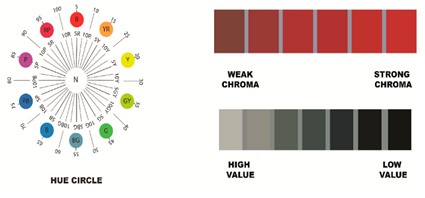Volume 3, Issue 10
October 2023
Spectrophotometers, Shade Guides, and Color Perception and its Relation to Digital Shade Matching in Restorative Dentistry
Hadeel Mokhtar, Omnia Yaghmour, Bashaer Alhalafi, Atheer Alkhaldi, Ibtehal Alotaibi, Tethkar Khoqandi, Abdullah Alshammari, Ahmed Alqarni, Ghada Alfirm, Yara Alhumaidan, Reem Alborai
DOI: http://dx.doi.org/10.52533/JOHS.2023.31006
Keywords: Shade, spectrophotometers, aesthetic, intrinsic factors
Achieving an aesthetically pleasing appearance in dental restorations is a complex task that depends on the accurate selection of tooth shade. The shade of a tooth is influenced by both intrinsic factors, such as light scattering within enamel and dentin, and extrinsic factors, such as the absorption of staining substances. As patient awareness and expectations regarding aesthetically attractive dental restorations have grown, so too has the pressure on dentists to deliver more naturally appearing results. Conventional approaches have often shifted towards artistic interpretation, but advances in materials and technology have prompted a shift towards more scientifically rigorous methods. Despite the availability of advanced devices for shade matching, their adoption remains low. Studies suggest that electronic tools can measure up to 100,000 dental shades, far surpassing the human eye's ability to detect only 1% of dental color variations. This paper calls for more research to examine the accuracy of various shade-selection techniques in meeting the rising aesthetic expectations in modern dentistry.
Introduction
The three fundamental elements of modern aesthetic dentistry include establishing a strong relationship with dental anatomy, utilizing composite resins and ceramics, and ultimately achieving a visually pleasing result (1). To get good aesthetic results in cosmetic dentistry, dentists must first determine the correct shade of a tooth's color, then choose and use the highest-quality material that closely matches the tooth, and lastly, communicate clearly with the lab personnel. The tooth shade's outcome results from the interplay of intrinsic and extrinsic staining factors. Intrinsic discoloration refers to the way light scatters and how enamel and dentin absorb light (2, 3). Conversely, extrinsic discoloration is linked to the uptake of materials such as red wine, tea, iron salts, and chlorhexidine on the surface of the enamel, specifically its pellicle layer, ultimately resulting in external stains (2, 4). There has been a notable increase in interest for using tooth-colored materials in modern-day dental restorations. Contemporary systems have acknowledged the rapid advancements in restorative materials for teeth, driven by patient demands and user preferences. These advancements have led to a variety of approaches for achieving excellent tooth aesthetics through traditional treatments. Nonetheless, traditional esthetic dentistry primarily emphasized artistic aspects. Consequently, restorative dentistry can be described as a fusion of the concepts of beauty and artistry (4). It has been noted that patients are becoming more informed about aesthetically pleasing dental restorations. Nonetheless, it falls on the dentist's experience and sense of aesthetics to provide a tooth reconstruction that not only enhances a person's looks but also appears natural (5). Based on scientific data about changes in the visual matching of color tones, various instruments have been created, although their adoption is uncommon. The aim of this study is to examine existing research to assess the accuracy of shade matching through diverse shade-selection methods. In recent years, both dentists and patients have developed a heightened sense of aesthetic appreciation for dental restorations that closely mimic natural teeth. Dentists are now tasked with the complex job of accurately matching the shade of dental prostheses with a patient's existing teeth, given the extensive variety of natural tooth colors available. Some dental prosthetics have failed to achieve a seamless match, primarily due to incorrect shade selection. Therefore, it is important for dental professionals to exercise extreme care when choosing shades to ensure optimal results.
Methodology
This study is based on a comprehensive literature search conducted on September 14, 2023, in the Medline and Cochrane databases, utilizing the medical topic headings (MeSH) and a combination of all available related terms, according to the database. To prevent missing any possible research, a manual search for publications was conducted through Google Scholar, using the reference lists of the previously listed papers as a starting point. We looked for valuable information in papers that discussed spectrophotometers, shade guides, and color perception and its relation to digital shade matching in restorative dentistry. There were no restrictions on date, language, participant age, or type of publication.
Discussion
Basically, two factors—intrinsic and extrinsic colors affect the tooth shade. Intrinsic color depends on the properties of enamel and dentin that reflect light, which can be affected by some systemic pathology or a pulpal disease. Extrinsic color depends on material absorption by the surface of the tooth, which in turn depends on the dietary intake of the individual (6, 7).
Three dimensions of color
Certainly, based on a detailed explanation of the three dimensions of color in dentistry according to the Munsell system and Vita Classic shade guide, Table 1 summarized the information in tabular format for easier understanding (7).
|
Table 1 shows the essential features and relationships between hue, value, and chroma in dentistry, as they relate to the Munsell system and Vita Classic shade guide (7). |
|||||
|
Dimension |
Definition |
Importance in dentistry |
Measurement scale |
Relationship with other dimensions |
Figures |
|
Hue |
The specific variety of a color that differentiates it from others in the same family. |
Allows for distinguishing between various shades of teeth like reddish or yellowish tones. |
Vita Classic guide labels like A for reddish-brown, B for orange-yellow, etc. |
Physiological and psychological response to wavelengths. |
Figure 1 |
|
Value |
The degree of lightness or darkness of a tooth's color, indicating how much light is reflected or absorbed. |
Categorized in Munsell method from white to black; affects the appearance of dental crowns. |
Munsell scale from white to black. |
Improving value can be achieved by increasing surface reflectivity or reducing chroma. |
Figure 1 |
|
Chroma |
The saturation or intensity of a color. |
Determine the vividness of the tooth color. |
Ranges from 2 to 10 for natural teeth according to Munsell. |
Inversely related to Value; as Chroma increases, Value decreases and vice versa. |
Figure 2 |
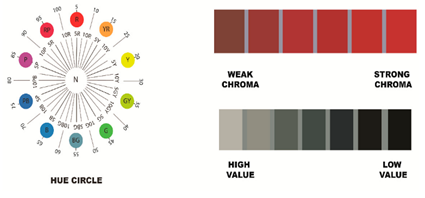
Figure 1: Three dimensions of color (adapted and re-drawn from ©1994 Encyclopedia Britannica, Inc., Chicago, IL, USA) (7).
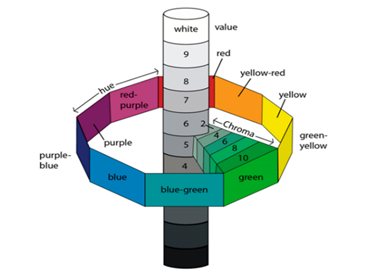
Figure 2: Munsell color system (adapted and re-drawn from ©1994 Encyclopedia Britannica, Inc., Chicago, IL, USA) (7).
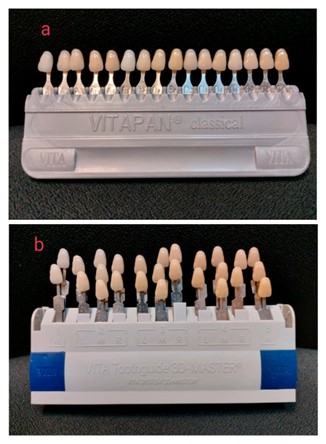
Figure 3: (a) Vita classical shade guide and (b) Vita 3d master shade guide (7).
Optical properties of teeth
The various optical properties of teeth beyond hue, value, and chroma have been summarized in Table 2 below.
|
Table 2 shows the different optical properties, their descriptions and implications in dentistry, influencing factors, and any relations to other properties for a comprehensive understanding. |
|||||
|
Optical property |
Description |
Implications in dentistry |
Influencing factors |
Relation to other properties |
Reference |
|
Metamerism |
A phenomenon where two colors appear the same under specific lighting but have different properties. |
Color matching must consider different lighting conditions to minimize metamerism. |
Types of lighting like fluorescent and natural daylight. |
-- |
Gasparik C et al. (8) |
|
Translucency |
Exists on a spectrum between opaque and transparent. Affects how much light is reflected back. |
Influences tooth color and how restorations are perceived. |
Light angle, surface texture, wavelength, moisture level, and mineral content. |
Tied to refractive index (RI) which is 1.62 for enamel. |
Rajan N et al., Tashkandi E et al. (9, 10) |
|
Opalescence |
Material appears one color when light reflects and another when light passes through. |
Enhances the brightness, vibrancy, and depth of teeth. |
Intrinsic properties of the material. |
-- |
Rajan N et al. (9) |
|
Fluorescence |
Emission of light after absorption of light or other electromagnetic waves. |
Mainly observed in dentin; affects chroma. |
Amount of organic material in the dentin. |
Lower chroma when more fluorescence occurs. |
Rajan N et al. (9) |
|
Texture of Surface |
Influences the direction and amount of light reflection. |
Affects visual appeal and perception of restoration. |
Surface features like lobes, stippling, striations, and ridges. |
-- |
Jouhar R et al. (7) |
|
Surface Gloss |
Optical property that gives a glossy appearance. |
Affects vitality and visual appeal of teeth. |
Intrinsic properties of the material. |
-- |
Alnusayri MO et al. (11) |
Measurement of color
The fabrication of an indirect tooth restoration necessitates effective communication between dental professionals and laboratory technicians. Additionally, selecting the right shade is often the most complex step in the restoration process to preserve the tooth's natural appearance (7).
Shades can be measured using two techniques: the visual technique and the instrumental technique.
Visual technique
The Munsell system, often represented in a three-dimensional color model, is a popular way to visually assess tooth color (Figure 2). The most common and economical technique for choosing tooth colors is using traditional shade recommendations. These guides enable the accurate matching of tooth color to a standard reference. However, when using this shade tab method, the accuracy of selecting a tooth's shade is fully dependent on the visual judgement of the observer (12).
Shade guides
In dental practice, shade guides, consisting of either standardized or custom-made color options, are employed to align with the natural coloration of teeth (7). Shade guides can be categorized according to the material they are constructed from, which may include composite resin, acrylic, or ceramic. Typically, shade guides should encompass the entire spectrum of natural dental colors. As a general rule, each shade tab is divided into an incisal, middle, and cervical section, with variations in shade determined by differences in translucency and color intensity (13). In the field of prosthetic dentistry, choosing the right shade is a crucial step that informs the laboratory technician's work in creating indirect restorations (14). At present, multiple shade guides exist for dental clinical applications, including the Vita Classical and Vita Tooth guide or 3D-Master shade guide, both produced by VITA Zahnfabrik H. Rauter GmbH & Co. in Bad Säckingen, Germany. These guides are based on Munsell's fundamental principles, which categorize color into three dimensions: hue (the distinct color), chroma (the color's intensity), and value (the color's brightness) (13-16).
Vita classic shade guide
In the Vita Classical system, the spectrum of color is divided into four main categories: A, B, C, and D, each representing a predominant hue or color name (Figure 3) (7). Group A consists of red and brown shades; Group B includes red and yellow; Group C features grey; and Group D combines red and gray. Within each letter category, there are further subdivisions indicated by Arabic numerals ranging from 1 to 4, resulting in a total of 16 tabs (as shown in Figure 3). As these numerals rise, the color's brightness (value) diminishes while its intensity (chroma) increases (17).
Vita 3D-master color guide
The shade guide features 26 tabs, which are sorted into five groups based on their brightness or value. As illustrated in Figure 3, within each group, the tabs are aligned along two axes: vertically according to color intensity (chroma), and horizontally based on the specific color (hue). The initial group has two tabs; the next three groups each consist of seven tabs; and the final group features three tabs. Additionally, each tab is marked with a number between 1 and 5, indicating its group and value level, which diminishes as the number goes up. The Vita 3D Master Shade Guide has shown several advancements over its predecessor, the Vita Classical. These improvements include a broader range of values, an expanded spectrum of red hues, and a more evenly distributed arrangement of shade tabs within the color space. Additionally, the organization of the groups has become more streamlined and precise (16).
Advantages of shade guides
Utilizing a visual shade guide is the predominant way to choose tooth color (5). It is cost-effective and long-lasting, meaning there is no need for regular updates to the guide. It offers a reliable way to match natural tooth shades. Dentists, dental assistants, and dental lab technicians commonly use it to convey the correct tooth hue, luminosity, and transparency (11). Moreover, they are widely accessible.
Disadvantages of shade guides
Shade guides face challenges in standardization, material consistency, and the accurate representation of natural tooth characteristics, making them a less than perfect tool for dental restorations (7).
Instrumental Techniques in Tooth Shade Selection
Shade guides are commonly employed for shade selection in dental practice, although this method is considered subjective due to various influencing factors such as age, gender, eye fatigue, observer skill, and ambient lighting conditions (18). While instrumental techniques for dental color matching are generally expensive and not readily available to many dental practitioners, their use is on the rise and gaining acceptance in the field (19). These advanced techniques include tools like spectrophotometers, scanners, digital cameras, and smartphones (20).
Spectrophotometers and spectroradiometers
Spectrophotometers are recognized for their precision, speed, and flexibility in color matching (21). These instruments measure reflected light energy at intervals between 1-25 nm across the visible spectrum (22). Their complex design involves various components for scattering light and transforming it into analyzable signals. Vita Easy Shade® V is an illustration of a spectrophotometer (Figure 4) (7). While older models use a single photodiode sensor, newer ones employ a diode array, enabling simultaneous measurements across wavelengths (23). They notably outperform human eye evaluations, with studies showing a 33% increase in accuracy and 93.3% more objective matches (24). Despite their efficacy, they are often best used in conjunction with visual color-matching techniques for a comprehensive approach, as each method has its own merits.
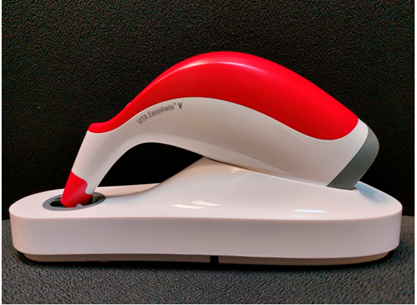
Figure 4: Vita Easyshade® V, Bad Säckingen, Germany (7).
Digital cameras and image processing solutions
Digital cameras represent the simplest approach to electronic color measurement, but they still require some level of manual shade determination through human observation (25). The use of digital imaging systems for evaluating tooth shade is increasingly common. The camera's quality and the image analysis technique play crucial roles in determining the system's reliability and accuracy. Some studies have indicated that when used alongside appropriate standardization methods, digital cameras can be reliable tools for assessing the color of both teeth and gums (17).
Intraoral scanners
Intraoral scanners, initially designed for digital impressions, have expanded to include dental shade measurement tools (19). These devices, equipped with high-definition cameras and LED lights, offer a detailed analysis of tooth color, but they are not without limitations. Factors like ambient lighting, the quality of color-analyzing software, and the shade guide mode can influence the results. While some studies suggest intraoral scanners could replace traditional methods like spectrophotometers for shade matching, others raise concerns about their accuracy. Although these scanners show promise, especially in terms of operator-independent results and providing detailed color information, they still fall short of being solely relied upon for shade selection. Hence, the use of additional instruments for shade assessment is recommended.
Restrictions of digital shade guide
Digital shade guides, while innovative, come with their own set of limitations that affect their reliability and application. Issues range from dependency on a stable power supply for accurate color measurement to inadequate recording of translucency across all systems. Additionally, the precise placement of the probe or mouthpiece is crucial for repeatable measurements, adding another layer of complexity. The technology also falls short in formulation modes, and its effective use requires a laboratory equipped with up-to-date systems. These restrictions make the digital approach not entirely foolproof or universally applicable in its current state.
Factors affecting shade selection
The following table summarizes factors affecting shade selection. (Table 3).
|
Table 3. Factors affecting shade selection. |
||
|
Factor |
Summary |
Reference |
|
Age-related factors |
Aging diminishes shade discrimination due to the yellowing of the eye's cornea and lens, affecting colors like blue and purple, especially after age 60. |
Redmond T et al. (26) |
|
Gender considerations |
No significant gender-based differences have been found in color recognition. |
Pecho OE et al. (27) |
|
Experience |
Existing literature does not confirm that experience significantly improves shade-matching accuracy. |
Jouhar R et al. (7) |
|
Eye color |
Brown eyes absorb lighter and wavelengths, but this doesn't necessarily impact color acuity compared to lighter eyes. |
Jouhar R et al. (7) |
|
Issues of color vision |
Color perception issues range from total lack of color sensitivity to varying degrees of hue perception deficiencies. |
Jouhar R et al. (7) |
|
The role of fatigue |
Eye fatigue can affect color perception accuracy, especially with multiple shade evaluations during a workday. |
Jouhar R et al. (7) |
|
Binocular discrepancies |
The difference in perception between the right and left eye can impact shade-matching accuracy. |
Medeiros JA et al. (28) |
|
Environmental aspects |
Factors like background color, facial makeup, and instrument reflections can affect perception, emphasizing the need for a neutral setting for accurate shade selection. |
Alomari M et al. (29) |
Recommended guidelines for clinical shade matching:
Organized methodology
Shade selection should be systematically conducted to ensure precision, reliability, and desired outcomes, which are crucial in cosmetic dentistry. The process begins by choosing value, followed by chroma, and lastly hue.
Lighting considerations
Optimal lighting is essential for accurate shade matching. While midday sunlight is ideal because it offers a balanced spectrum of light, dental offices often rely on artificial lighting to replicate these conditions. Though not a perfect substitute, artificial lights are generally adequate for clinical needs (30).
Environmental considerations
The surroundings should ideally be free of bright colors that might distort the shade-matching process. Interfering colors from clothing or jewellery can be covered, and lipstick should be removed to avoid altering color perception. Light grey is the recommended background color, and shiny surfaces that create glare should be avoided (30).
Tooth condition
The tooth in question and its adjacent teeth should be free from stains, plaque, and other deposits. The tooth should also be kept moist, as dryness can make it appear whiter. Moreover, it is advisable to wait 2-3 weeks after bleaching before selecting a shade. The teeth should be divided into three areas for measurement, taking into account different properties like enamel density and translucency (31).
Operator positioning and timing
The operator should maintain a distance of about 2 to 6 feet from the patient's oral cavity for accurate shade matching. The dental chair should be adjusted so that the patient's teeth are level with the operator’s eyes. It is also preferable for the operator to finalize the shade selection in the morning to minimize the effects of eye fatigue (11).
Conclusion
Choosing the correct tooth shade is a complex process that significantly influences the aesthetic results of dental restorations. Efforts have been successful in transitioning from less reliable visual methods to more objective digital techniques. Current research suggests that these digital methods are generally more accurate and precise than their visual counterparts. However, there is still room for improvement to reach the ideal outcomes for shade determination. Among various methods, dental spectrophotometers stand out for their superior accuracy and precision, although they require a controlled clinical environment and technological advancements for optimal performance. Future research is needed to address the limitations of digital tools and enhance their accuracy and precision, with the aim of eventually replacing visual methods entirely.
Disclosure
Conflict of interest
There is no conflict of interest
Funding
No funding
Ethical consideration
Non applicable
Data availability
Data that support the findings of this study are embedded within the manuscript.
Author contribution
All authors contributed to conceptualizing, data drafting, collection and final writing of the manuscript.
